What’s the first thing new traders usually learn when starting trading?
Perhaps… Moving averages?
Chart patterns?
Support & Resistance, maybe?
How about Candlesticks Patterns?
Technical analysis has the most attractive topics after all, right!
However, while those concepts can help you enter and manage a trade…
…they won’t keep you in the game in the long run.
To give yourself a chance at keeping your portfolio intact, you need an essential lesson in…
Risk management!
And that, my friend, is what I’ve prepared for you today.
Specifically, you’ll learn…
- The simplest and quickest risk management method to apply in stocks
- A precise risk management method that allows you to be flexible with your risk on the stock market
- Accessible position sizing calculators that you can use anytime without registering or downloading anything
- Advanced tips on how to control your risk depending on the market condition and your trading method
Now, this training guide is more than just a Wikipedia entry on risk types.
I’ll show you exactly how to apply these methods and which tools you need to get started today.
Sound good?
Then let’s begin!
How to apply risk management in stocks: Portfolio allocation method
In this section, I’ll teach you the specific calculations for how position sizing works.
…so that you understand exactly how to recreate them yourself!
Now, this position sizing method is best used:
- For diversifying your portfolio
- For both trading and investing
- For any form of trading or investing when not dealing with leverage
The portfolio allocation method works by setting a “fixed percentage” limit when buying a stock.
For example, say you have a $3,000 trading account.
And let’s say that you want to have a maximum allocation of 10% per trade.
This means that if you’re interested in buying a stock, you don’t want to buy shares worth more than $300…
And by now…
You should see that having a 10% allocation gives you a maximum open trade of 10…
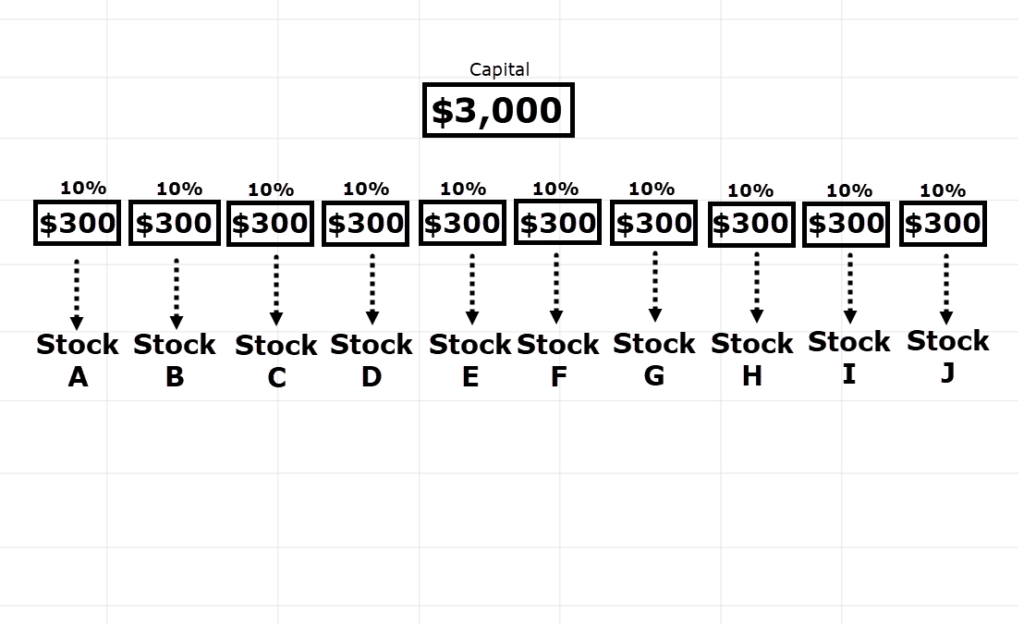
Make sense?
But you might be wondering…
“Okay, but how does this work in the real world?”
“How exactly do I calculate how many shares to buy when the stock’s price is $1.92?”
Let me show you…
This time, let’s say that you have a $6,500 trading account.
And that a 10% allocation means that you’ll buy stocks worth up to $650.
This gives you a maximum open trade of 10…
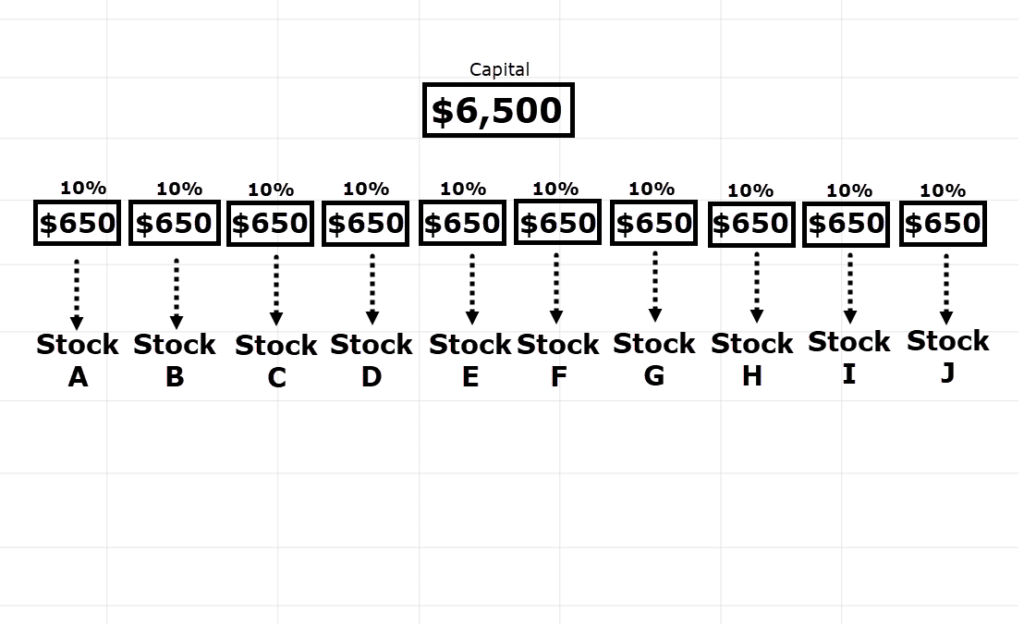
Now, you find three stocks you like (because they are currently on a breakout!)…
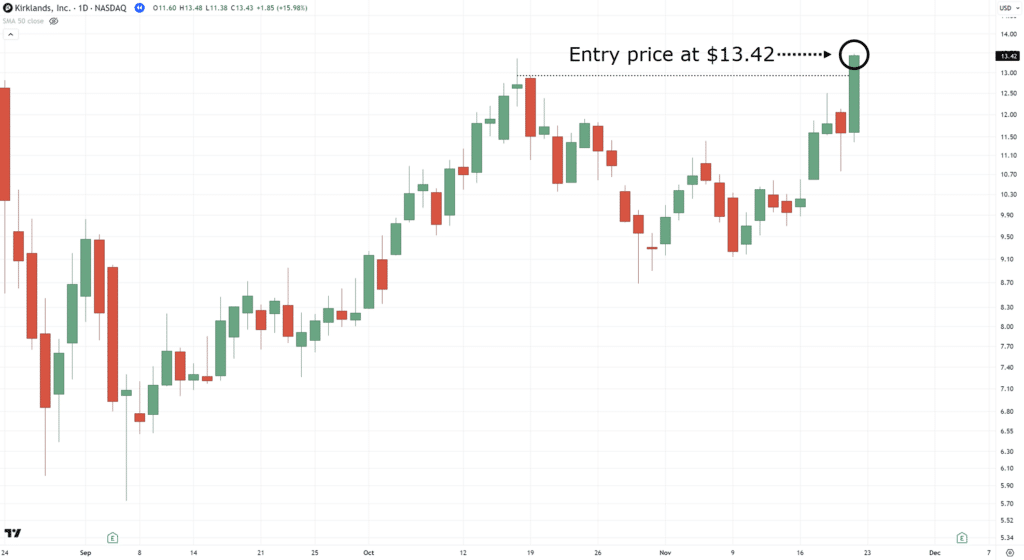
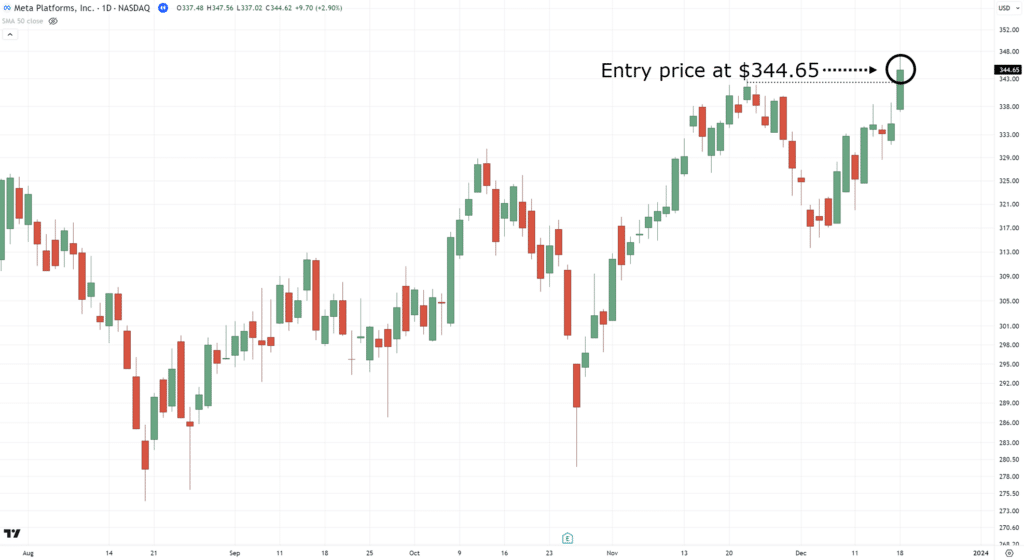
The question now is…
How many shares can I buy?
First, take their closing prices:
- KIRK – $13.42
- CRWD – $176.25
- META – $344.65
The next thing you do is divide those closing prices by your 10% allocation amount, $650…
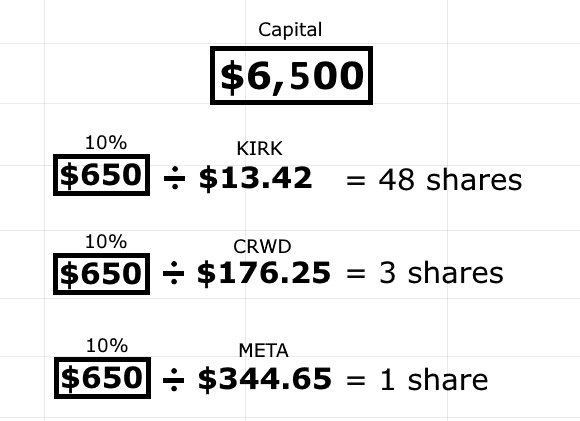
And voila, now you know exactly how many shares to buy!
(And yes, you’ll want to “round down” the calculation as you don’t want to allocate more than 10%)
Now, you might be wondering…
“Where do I place my stop loss?”
And that is a very good question!
Simply speaking, calculate it by subtracting 10% of the last closing price…
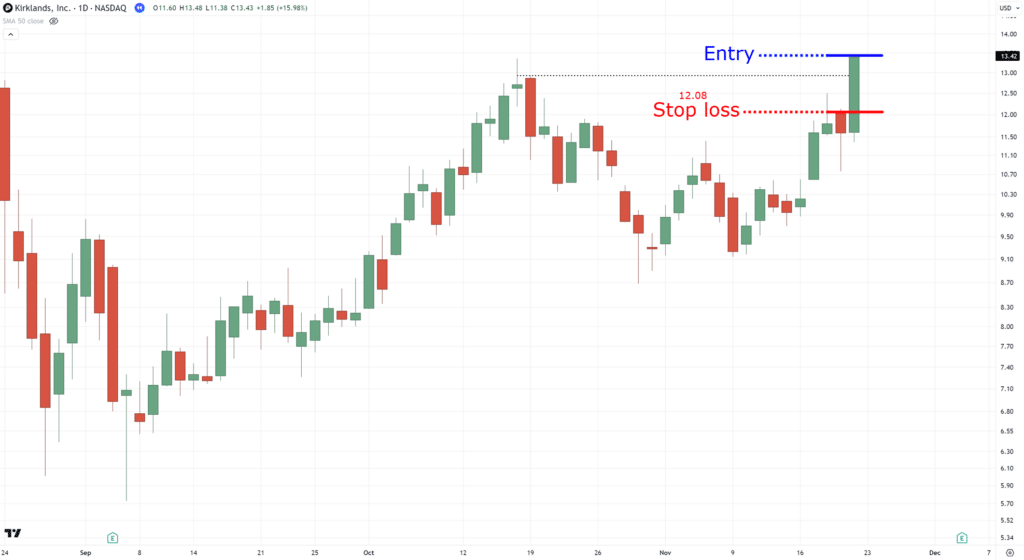
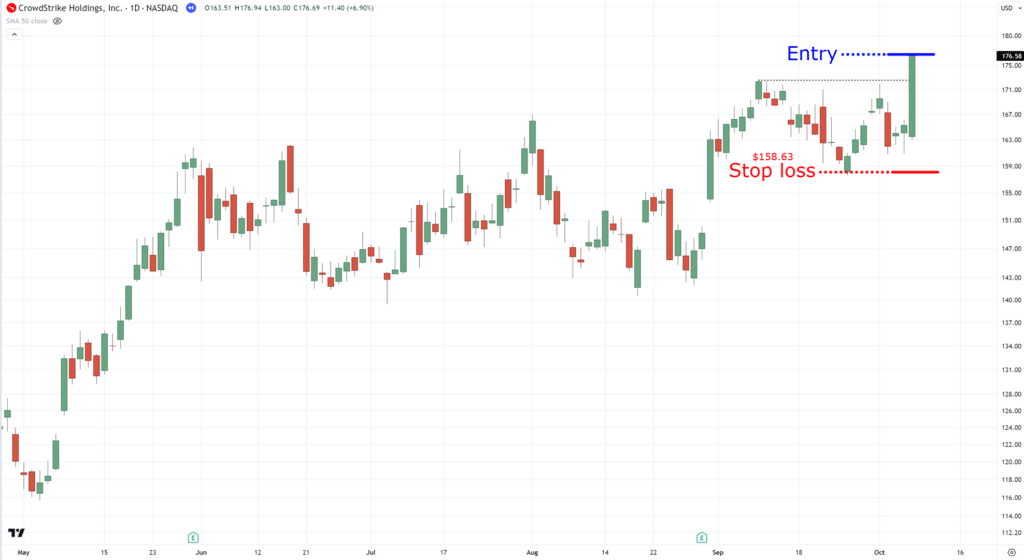
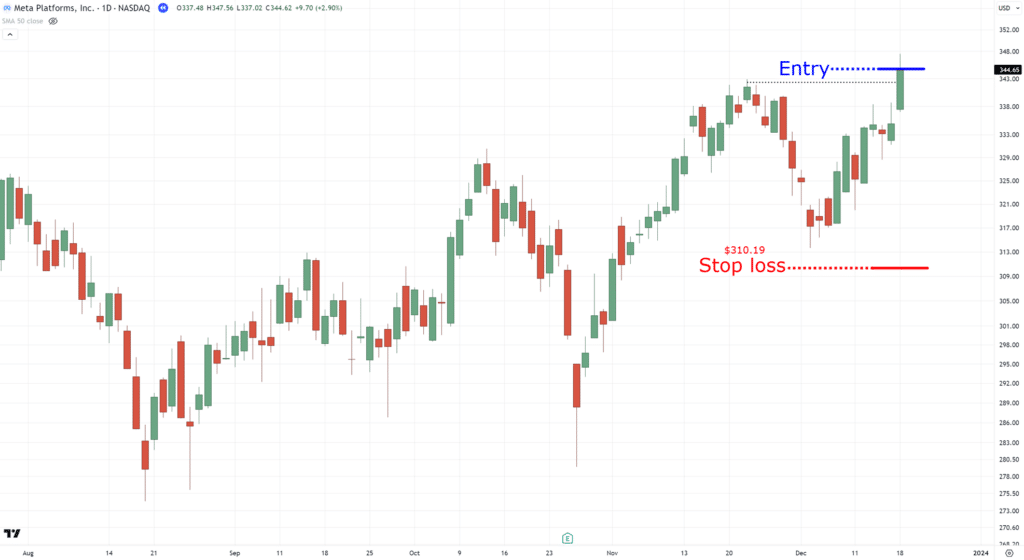
By doing so, it means that if your stop loss is hit…
…you’ll lose no more than $65.
I’ll explain more about this concept shortly, but knowing the fixed-percentage stop loss goes hand-in-hand with the portfolio allocation method.
Got it?
So, let’s move on to the next position sizing method…
How to apply risk management in stocks: Percentage method
So, if you’re trading with stocks without any leverage, then using portfolio allocation position sizing makes sense.
However, if you are trading with leverage, then knowing this percentage position sizing is crucial.
In the previous risk management method, the formula was simple:
Shares to buy = (Portfolio balance x 10% allocation) / Stock price
…but this time, you need to ramp things up just a little!
Now, before I share with you some formulas here, I want you to know the principle of this risk management method:
If your stop loss is hit, you position size in a way that you only lose 1% of your account balance
So, for example…
You have an $8,000 account, 1% of that capital is $80.
This means that if my stop loss is hit, I want to make sure that I don’t lose more than $80 on my overall portfolio.
Again, this so-called “1%” differs from the allocation, as it refers to the stop loss.
But you might ask:
“What makes this position sizing method good?”
Well, the beauty of it is that you can be flexible in where you place your stop loss.
You can place a tight stop loss, and still make sure that you only lose 1% when your stop loss is hit…
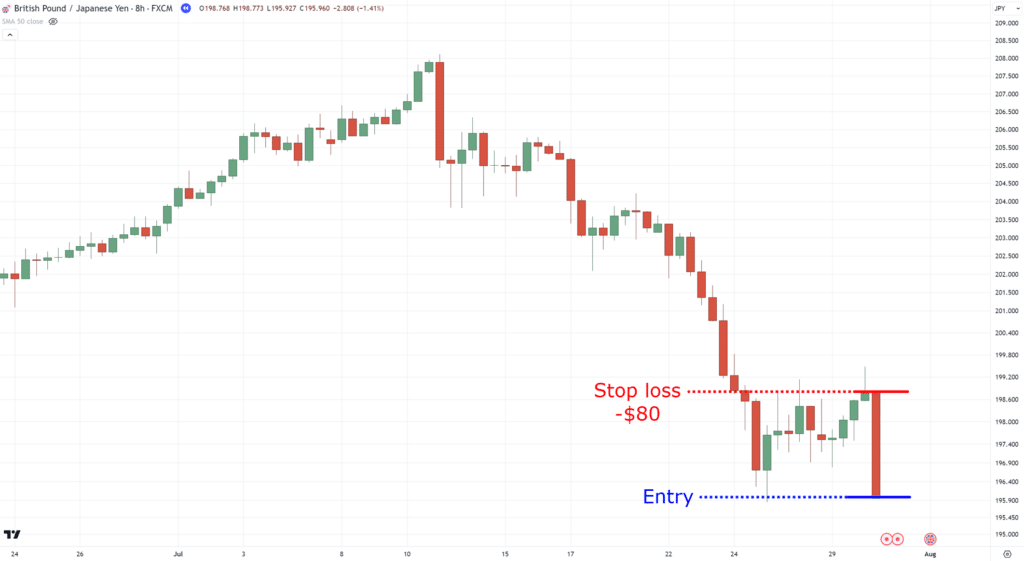
You can have a wide stop loss, and still make sure that you only lose 1% when your stop loss is hit…
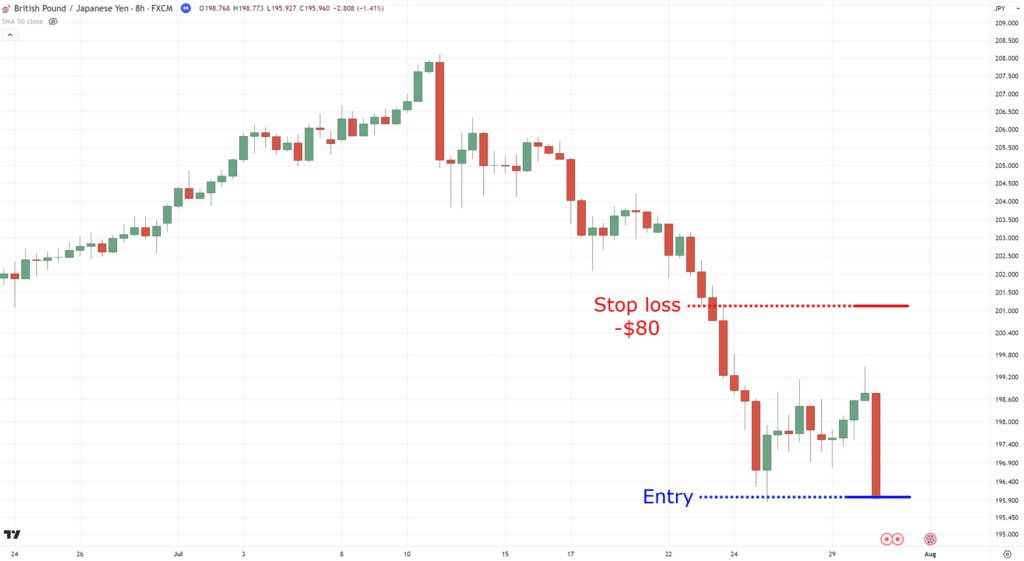
See what I mean?
This gives you flexibility on where you want to place your stop loss, as your potential loss will remain static.
So, back to the question:
How do you apply this?
For stocks, go by this equation…
Shares to buy = Risk amount / (entry price – stop loss price)
Let’s take the previous example to illustrate.
I first need to subtract the entry price and the stop loss price…
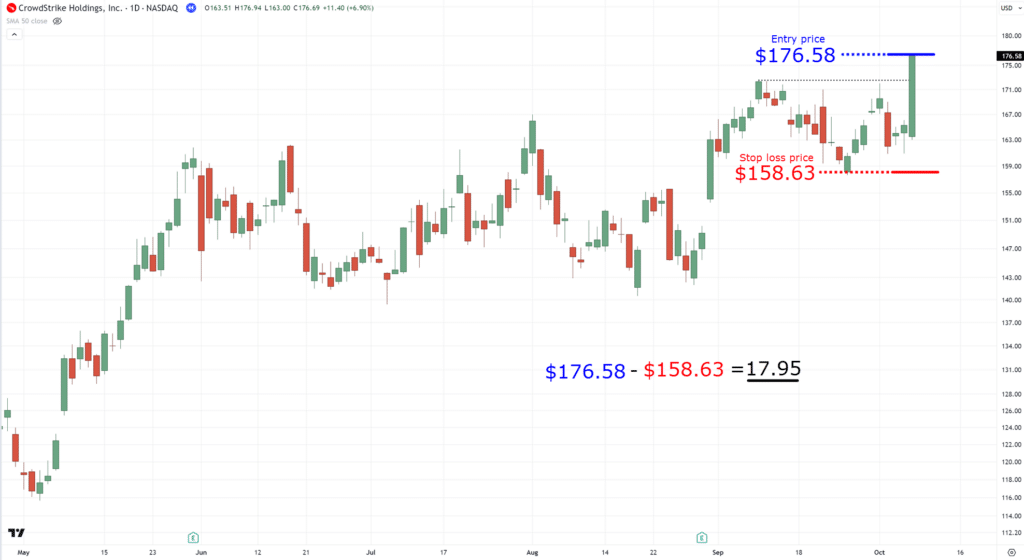
Finally, I just divide it by 1% of my $8,000 account, which is $80!
After doing these calculations, you can work out how many shares to buy…
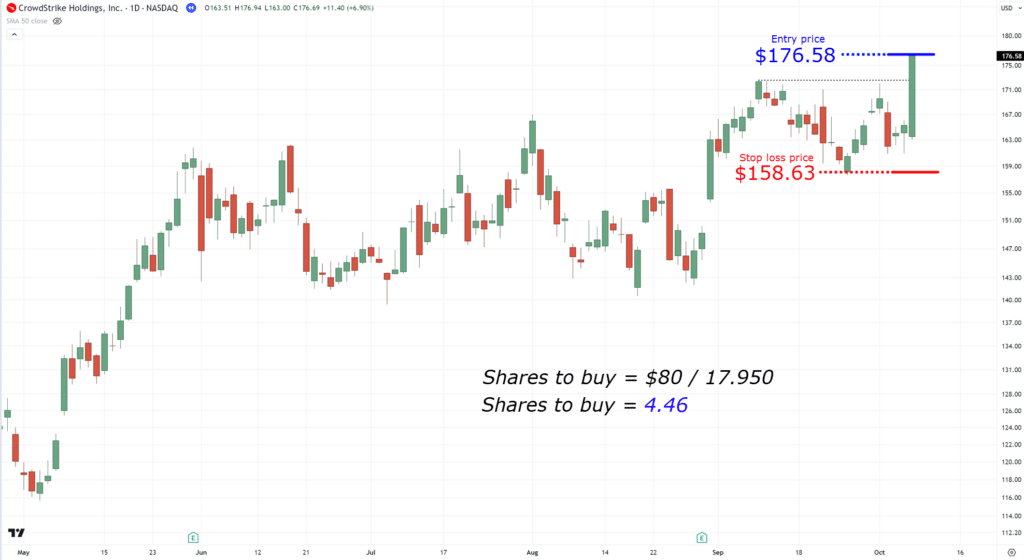
In this case, if you buy 4 shares at that entry price, even if your stop loss is hit, you will not lose more than $80.
Still with me?
Great!
Because from here on, things get a whole lot easier…
Next, I’ll share with you different tools on how you can apply risk management to stocks.
How to apply risk management in stocks: What tools should you use?
The goal of this section is to automate your risk management.
Alright, I know what you’re thinking right now:
“Why didn’t you start with this in the first place?”
Well, nothing feels better than owning the knowledge you learned – and it makes more sense than blindly following someone else’s calculation, right?
So, here are some basic criteria I will lay down for what kind of risk management tools you’ll use:
- The risk management tool must be free (no registration required)
- The risk management tool must be easy to use and understand
- The risk management tool must require no installation or download
Sound awesome?
Well, I meant it when I said that you can apply everything you learned as soon as you finish this trading guide!
So, what is the tool that meets these criteria?
The best position-sizing tool for stocks
Fortunately, this tool was released very recently – while I was writing this guide for you, in fact!
So, to give proper credit… it’s the position sizing tool of Adrian Reid:
Enlightened Stock Trading’s Position Size Calculator
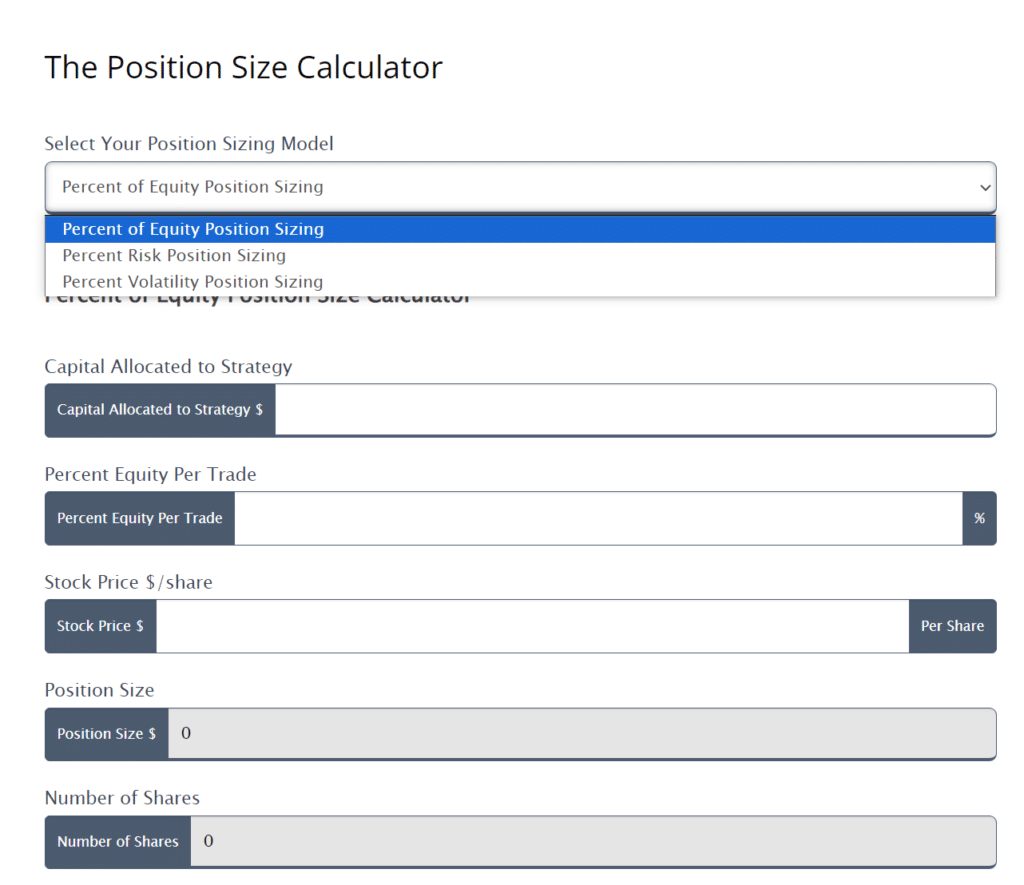
What I love about this tool is that it’s an all-in-one solution, giving you everything you need to know about how to apply risk management on stocks.
Imagine automating everything you’ve learned in this guide so far… all in one place!
For example, let’s say you have a capital of $3,000, and you’re allocating 10% of your capital per stock.
And let’s say the stock’s price on entry is $1.50 per share.
How many shares do you buy?
Well, just plug in the numbers…
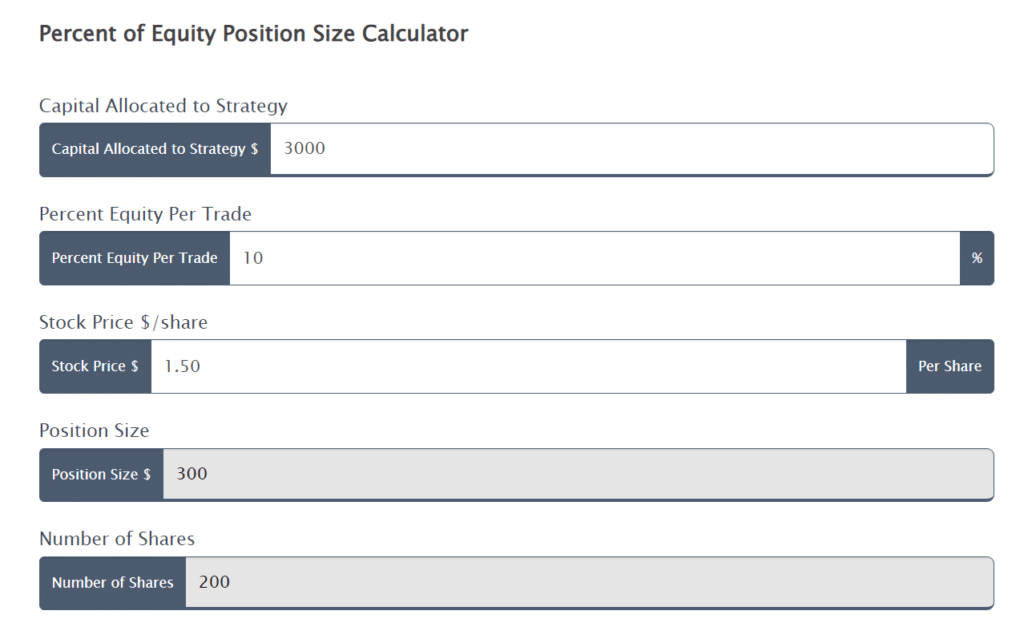
then bam!… you get 200 shares to buy!
Easy-peasy!
But how about the other position sizing method I shared with you?
Yes, the website has that, too…
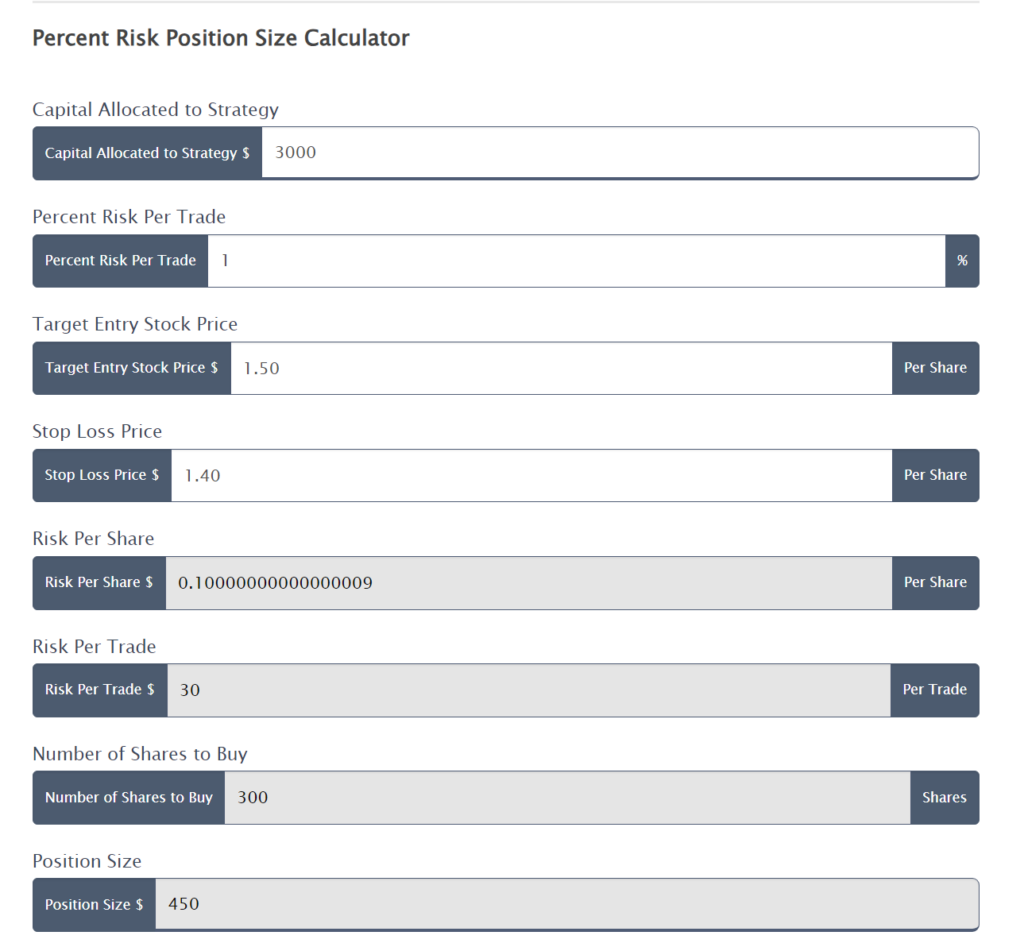
In the example above, I placed the same capital amount.
But this time, I entered that I’d be risking 1% per trade, that the stock’s entry price is $1.50, and I wanted the stop loss at $1.40.
And what do you know – I can buy 300 shares based on the calculation!
OK, but what if you felt that the stop loss distance was too tight and wanted to place it out further?
Well, that’s the beauty of this particular risk management method, my friend!
You can be flexible about where you want to place your stop loss but still maintain risk.
So, if your stop loss now is lower, at $1.20…
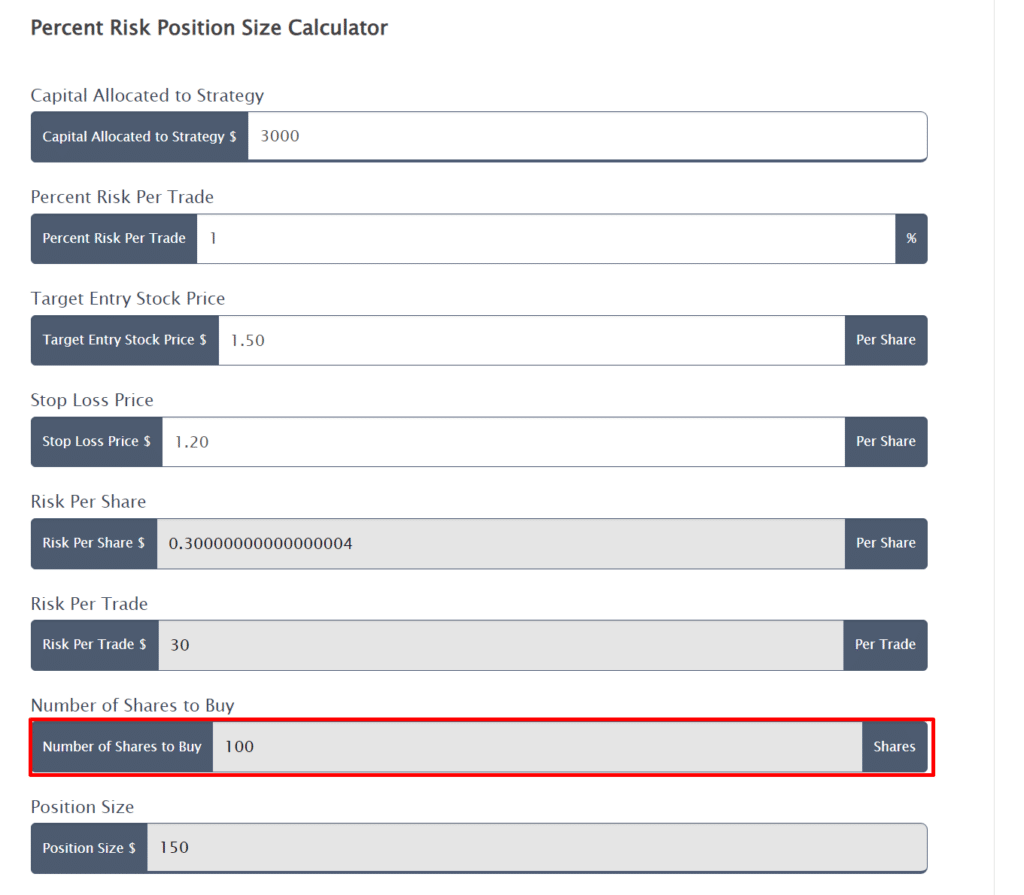
The calculator shows that I’d want to enter this trade with 100 shares.
It’s a wider stop loss, but still the same risk, at no more than 1% per trade.
Pretty neat, right?
And although I’m sure there are a lot more calculators out there that fully automate this process…
…or trading platforms that already have integrated risk management calculators in them, too…
In this case, I want to do my best to share the most accessible calculators out there with you.
I certainly didn’t want to spend half of your reading time on how to register with certain brokers or install specific indicators on your platform!
Now, in the next section, I’m going to build on what you’ve learned in this guide so far.
Maybe you noticed I always ask you to risk 1% of your account per trade or allocate 10% of your account per trade?
But…. when can you change those numbers?
When should you risk 0.5% per trade?
How about 2% per trade?
And what about allocation?
When do you allocate 20% of your capital per trade on a single stock?
How do you go about it?
Read on to find out!
How to apply risk management in stocks: The secret to changing the parameters
So, how you modify your risk depends on the market condition and what type of trading style you have.
That’s why, in this final section, I’ll share with you how to apply:
- Risk management for bull markets in the stock markets
- Risk management for bear markets in the stock markets
- Risk management for intraday trading in stocks
Let’s take a closer look…
Risk management for bull markets in the stock markets
There’s a common saying:
“When it’s a bull market, everything you touch turns into gold…
…but everything you touch turns to shit in a bear market!”
It’s precisely why you should capitalize on a bull market when it comes but be defensive during a bear market.
As you know, the common percentage for portfolio allocation is 10%, which gives you a maximum of 10 open trades.
But consider being more aggressive in your portfolio allocation whenever a bull market occurs.
This is done, for example, by allocating 12.5% per stock, giving you 8 maximum open trades.
It concentrates your portfolio a bit more, meaning you could face greater losses but also make greater returns.
And if you wish to go for the most aggressive portfolio allocation percentage, you can allocate 20% per stock, giving you a maximum open trade of just 5.
So, by using this concept, you gain more flexibility to engage with your account, trying to capitalize on the tide of a bull market.
Risk management for bear markets in the stock markets
Admittedly, in a bear market, it doesn’t have to be the case that everything you touch turns to shit.
It just means that finding an “outlier” trending stock across a sea of blood is much harder!
So, you have two options.
First, you can stay in cash.
Second, you allocate less, such as a maximum of 5% per stock, giving you a maximum open trade of 20.
Of course, you always want to enter trades with a valid trading strategy, too.
But another important question is:
“Why are you doing it like this, with so many open trades?”
The answer, my friend, is so that you can increase your odds with a larger sample size of open trades.
Chances are, a lot of those stocks you’re holding during a bear market will most likely fail.
However…
Once you spot a golden egg in your basket in the middle of a bear market, it’s time to sell your laggards and scale them into your winners!
Basically, the concept is that on a bull market, you’d want to be more aggressive.
But on the bear market, you’d want to be more defensive.
Make sense?
Good, because you’ve just finished a complete guide on how to apply risk management in stocks!
With that said, let’s go over a summary on what you’ve learned today.
Conclusion
Here’s the truth:
Knowing how to apply risk management in stocks must come first (and certainly not last!)
Taking your time over it ensures you don’t blow through your account, no matter how many times you mess up!
And in the worst-case scenario?
Your portfolio bleeds, giving you enough time to learn from your mistakes and seal the wound.
So, here’s a quick recap of what you’ve learned today…
- A portfolio allocation position sizing method is one of the most reliable ways to trade markets without any leverage.
- Having a risk-based percentage position sizing is a bit more complicated to apply, but gives you both the flexibility of placing your stop loss anywhere while also managing
- There are free and accessible position sizing calculators ready for you to access, such as calculators from Enlightened Stock Trading.
- On a bull market, consider allocating more shares per stock, but on a bear market, you must be defensive by allocating less.
So, there’s your complete guide, from beginner to advanced, on how you can surgically control the risk parameters of your portfolio!
But actually, I want to hear what you think.
What are some other risk management methods you know of?
And if you trade crypto or forex, how do you apply risk management there?
Let me know in the comments below!


